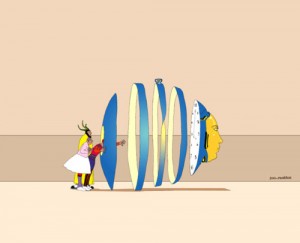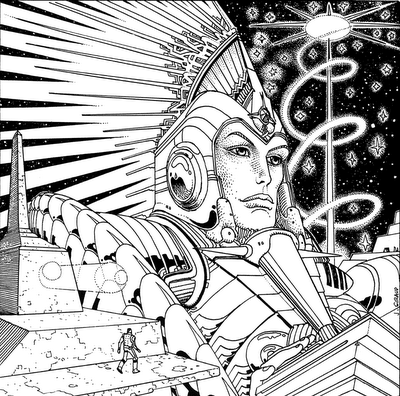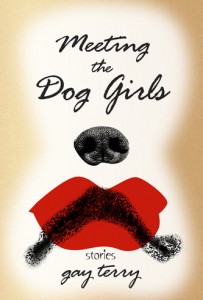MOEBIUS was the main reason I used to buy Heavy Metal magazine (the American version of France’s Metal Hurlant) whenever I saw a new copy on the newsstand. I met him at the World Fantasy Con in Saratoga Springs some years ago and he was genuinely happy and excited to talk about Emsh, who, he told me, inspired him to become an illustrator and artist. As a teenager I wanted to draw like Moebius…I still do. A real lost to pop culture, science fiction, comics, and the art world.
THERE IS a new interview with Gay Partington Terry, author of Meeting the Dog Girls here. The following is a sample:
I grew up in a “patch town” near the West Virginia/Pennsylvania border, so I write about mine subsidence a lot. When you’re unsure about what’s going on under your feet, it brings up all sorts of things. I was a shy only-child with plenty of time to read and daydream. My dad was a magician so the line between real and imaginary was blurred. [more]
A SUCCINCT commentary of the Amazon vs. IPG and independent presses that runs parallel to our own thinking can be found at The Digital Reader. A sample: “I am aware that many ebookers would be happy to see every publisher and distributor disappear, thinking that when that happens authors will flourish by directly dealing with megacorporations like Amazon and that the consumer will benefit from even lower prices. Unfortunately, history proves that such expectations, in the absence of government price regulation, simply do not come to fruition. Monopolies ultimately result in price rises for consumers….” and this: “Once Amazon has squeezed the publishers and distributors dry, and once many authors have decided that they are better off self-publishing and dealing directly with Amazon, how long will it be before Amazon starts squeezing authors dry? And once authors are squeezed dry, how long will it be before Amazon starts squeezing consumers?”
OUR DISTRIBUTOR Independent Publishers Group (IPG) has informed us that Kindle versions of our books will no longer be available at Amazon.com due to changes in terms by Amazon that would reduce already narrow margins for all IPG publishers. A little over a year ago Amazon attempted to bully major publishers into accepting untenably low prices on Kindle e-books and failed when the “big six” publishing houses held firm—now Amazon has turned its attention to squeezing independent publishers. That may be cold-blooded capitalism, but now that Amazon has become a publisher itself, it is perfectly willing to take every advantage of also being in the catbird seat as a major bookseller to put a pecuniary gun to the head of publishing competitors. Heretofore book publishers of different stripes have always gotten along. I can firmly state that there is no zero-sum thinking among independent publishers. The gains of one publisher do not diminish those of another. If Amazon thinks it knows best how to price books, it can now put its theories into practice with its own publishing venture. However, Amazon also believes that it should be allowed to lower prices on other publishers’ offerings. Of course this unilateral decision making by Amazon really serves Amazon’s interest while putting independent publishers at risk. Amazon presents itself as the new paradigm in publishing, but at heart it reveals a grocery clerk’s mindset that feels resentment at the fruit cart that sets up for business across the street. Naturally, one should not expect moral fiber from a giant corporation whose interest in books is the same as its interest in lug-wrenches: units to be sold at profit. (It should always be kept in mind that Amazon has no affinity for the written word.) Amazon is used to dictating terms to vendors and it does not look any more kindly upon publishers or publishers’ bottom lines. It may seem a stretch of the imagination even to envision Amazon as the sole publisher in the country, but it is not a stretch to see Amazon as the sole dominant bookseller—this is Amazon’s CEO Jeff Bezos’ wet dream. What Amazon is doing as a publisher is producing a store brand, a knockoff of a product that is sold alongside the original, but at a cheaper price. More choices are good for consumers, but how would buyers react if they go into a Wal-Mart and all they see are store brands on the shelves? Far fetched, perhaps, but Amazon has shown by its actions that it has little concern for publishers or readers.
Nonstop Press books that are available in e-book formats, including the Kindle mobi format, can be bought right here and from other online ebook sellers. Ebooks from nonstop-press.com are DRM-free. You get free lifetime access, multiple file formats, free updates. Support your local bookseller and publisher.
As a teaser to the book here is the introduction to Why New Yorkers Smoke:
“A single flight of planes no bigger than a wedge of geese can quickly end this island fantasy, burn the towers, crumble the bridges, turn the underground passages into lethal chambers. The intimation of mortality is part of New York now; in the sound of jets overhead, in the black headlines of the latest edition.”– E. B. White Here is New York 1948
FEAR IS AN EMOTION that a lot of New Yorkers live with even if they don’t like to acknowledge it visibly. The city is a place where just about anything can happen at any moment. But what is it like when New Yorkers truly find themselves face to face with fear? As a New Yorker myself I live daily with artifacts and memories, the quiet panic and cold eyed encounters that can blow up at any moment and pull the ground right out from under your feet. New York City demands much from its inhabitants including involvement and aloofness. Many times New Yorkers have to be both emotionally hot and cold at the same moment. Outsiders have some trouble understanding this dual mindset but anyone who comes here — not just as a tourist — and spends any amount of time dwelling in any of the five boroughs will soon understand and develop the right attitude to fit right in and not stand out to would-be predators.
Many New Yorkers are not born here. They are drawn here by some uncanny allure. It is as if the city has become the back streets for the country, streets full of seedy looking bars from which strange music and laughter emanated, enticing the brave, the adventurous and the foolhardy. The balance of temptation and trepidation has always existed in a place that the native Indian tribe was quick to sell to Dutch traders. This collection is a fictional attempt to present some of the terror in the hearts and minds of a few of the sundry gathering of people that have chosen to live here despite all the warnings and I-told-you-so comments from outsiders.
The storytellers in this book weave a spell of fear and anxiety in juxtaposition with my city. While many Americans have felt this fear over the past decade, few have lived on the frontlines. All of the authors presented have some connection to the city. Some are born here (Barry N. Malzberg, Greenberg). Some have lived here in the past (Scott Edelman). Some are emotionally bonded to it (Don Webb and Paul Di Filippo). Most make their home here (Carol Emshwiller, Aligria Luna-Luz, Laxey, Lawrence Greenberg, Paige Quayle, Gay Terry and Becky Roth). And, as a sidebar, this volume forces me into thinking that Brooklyn has become the present day equivalent of the Paris of Hemingway and Joyce. But these writers’ Paris sojourns had little real impact on their writing. Today Brooklyn has become the Left Bank of New York City, even if that borough is on the right side of the East River. Hemingway and Joyce went to Paris partly because it was cheaper to live there, and some of this still applies to Brooklyn writers, but there is no Manhattan/Brooklyn class tension on display in Why New Yorkers Smoke. The economy has gone bad for everyone.
It’s not just a New Yorker thing — all Americans are now expected to live in dread 24/7. Our media has become very good at promoting spontaneous fear and loathing since 9/11. Of course they will deny it but all one has to do is pay attention to the-sky-is-falling TV weather reports, when a big storm is brewing, to see a basic scenario of how things work. Bob Dylan, like E. B. White, now appears more prescient when he said, during the 1960s, that one did not have to be a weatherman to know which way the wind is blowing. Whether media is following the piper or leading the horde still remains to be seen.
Fear has been in our bones since our ancestors first built a fire at the mouth of a cave and searched the darkness outside for glowing eyes. It is not going away any time soon. This book does not promote fear. It is not propaganda. It is not a chronicle of catastrophes. Fear can inflame ignorance, which is the opposite of our intent here. This book does show that the boogie man is a slippery character. He is not always who you would expect him to be. It would behoove us all to discriminate between real and imagined boogiemen. These stories are a start.
WE ARE ALWAYS EXCITED when we publish a new book, now we are especially thrilled with the publication of a first book from Gay Terry titled Meeting The Dog Girls, now in stores or available from our website. Our readers can meet the author in the following interview.
Where did you grow up?
Northern Appalachia, in the mountains between Pittsburg & the West Virginia border: deer hunters, coalmines, isolation.
What got you first interested in writing?
It must have been an event in a past life—I’ve had the compulsion to write ever since I could hold a pencil. Periodically, I’ve given it up in frustration but ended up scribbling in notebooks, journals.
What were you reading back then?
At a young age, I started reading books about the sea, pirates and legends, true accounts… I wanted to captain a ship even though I’d never seen an ocean. I was bad at math, and algebra did me in so I gave up the dream of navigating a ship (and its a good thing because, boy, do I get seasick fast!). In junior high I started taking books out of the library on the basis of title and cover. I read a lot of mysteries. One day I picked up a Philip Jose Farmer book and got hooked on science fiction. In college I decided I had to read classics, books you never see in back country schools that train you to be housewives and miners. I was totally bored till I got to Kafka. Oh, yes, and there was Mad Magazine. My friend, Patti, & I saved up our money to buy one copy between us and read every word.
So what made you think you could write?
Well, I’m still learning… I wrote for school newspapers in high school & college. I got thrown off my high school paper at the end of my senior year for writing a particularly bloody & brutal valentine poem, but it didn’t discourage me. I realized early that I wasn’t good at true & false tests or multiple-choice tests (I tend to see hordes of possibilities), but give me an essay test & I can ace it with no problem (as long as spelling doesn’t count).
You currently in a writing workshop run by Carol Emshwiller, how does that work?
We bring in our work and read it, then Carol goes over it carefully. Now her eyes are giving her a lot of trouble but she’s a very perceptive listener. She’s been extremely encouraging and I really value her advice.
Do you think Carol’s workshop has helped your storytelling?
Yes, definitely. Not only Carol, but everyone in the group is very astute, very helpful, intelligent and creative is all kinds of ways.
In your introduction to Meeting the Dog Girls you state that a few of the stories came from a diaries that turned into an illustrated autobiographical novel. Care to elaborate?
I have this really quirky family photo collection and a rich fantasy life that’s tightly entwined with “reality,” (so tightly, that I see no reason to acknowledge the difference; our fantasies are a part of our reality, aren’t they?) So I used the photos to illustrate my life. It’s called:
REMAINS: Or Dead Relatives, Real and Imagined
Preface
The clicking you hear is the sound of wind slapping the rope against the flagpole. The caretaker’s gone home; he leaves every day at four. Everyone else in this cemetery is dead. I come to watch the sunset. The people on this hill have the best view of town. Of course the price they pay for this view is unfortunate.
Ok, it’s about death, but it’s darn funny.
____________
To read a story from Meeting the Dog Girls see below. To buy the paper or ebook click here.
I had been reading Carol almost from her earliest publications, “Pelt” in Judy Merril’s yearly anthology, “A Day at the Beach” upon its appearance here in F&SF. This was 1964 when we first met, somewhere in there, so she’d published sixteen or eighteen stories. She was just then, I think, truly coming into her own. You sensed the constant simmer, could almost hear the pot lid chattering, as she spoke about fiction.”
Read the full review by James Sallis in this month’s issue of Fantasy & Science Fiction here.
The following excerpt is from the new book
Meeting the Dog Girls
by Gay Terry. In bookstores now.
The Line
THERE IS NO BEGINNING, no end to the line, just women waiting. The women are beautiful in a disheveled sort of way. A slick of sweat illuminates skin in sunlight and moon glow whether the complexion is dark or pale; the powdery dust adds glistening texture. We don’t look around much; we wait. Though there are many of us, we’re all too exhausted to be companions to each other. Once in a while we move forward ever so slightly. The children do not play; they’re much too lethargic from hunger. They stare out from behind mothers and strangers or weep quietly.
It does no good to worry. We stare into space. We attempt to patch our ragged garments. We wait enshrouded in our own thoughts. Yesterday there was a great storm so we’re feeling cleansed. We’re lucky to have warm weather and sun now. When the rainy season comes, we’ll have to dig out our old tarps and endure the smell of mold.
The woman ahead of me picks nits out of a small girl’s hair; perhaps it’s her daughter. Like the line, there is no end to the nits. She crushes them in her fingers and eats them or feeds them to the girl. Both are so thin that you can see bones through the skin, but their faces are beautiful. Their dark watery eyes are deep-set, and chapped lips perfectly rounded. In front of them an old woman sits like a stone reliquary, lines of dignity set into her face and pendulous breasts resting beneath her thin dress. The woman behind me never looks up. Her sad eyes are intent upon the earth, her head intricately wrapped in yards of faded muslin. I asked where she came from, but her answer was unintelligible. It’s possible that none of us really know what we’re moving toward. At least we’re not being shot at and the KEEP workers come by occasionally with water and a little food.
Mornings go quickly. Afternoons are intolerably long, hot, and dull. Evenings we eat the hard biscuits and bruised fruit we’ve hoarded all day. At night there are stars to watch, some shoot across the sky from above; some rise up from the ground. The expanse of sky makes our brief lives and hardships seem small. In the relative coolness of night, we sleep. Somehow, mornings are hopeful – even without promising expectations.
I sit on my bundle of belongings when I’m tired, curl up around it at night. There isn’t anything in it but rags, a cup, and a dish or two. I wrap myself in the tapestry my great grandmother wove. It was kept in the ancestor chest at my mother’s house, only brought out on special occasions. It’s all I have left of a life that may have been a dream or a dream that may have been a life. Like me, it has begun to fade and unravel. During the day I attempt to patch it, but it wears faster than I can sew. I’ve run out of scraps with which to piece it back together and my fingers are becoming stiff and unresponsive.
I keep three photos in the pocket of my dress. One is a smiling child with parents, one a street in a small town, the other is so worn that I can no longer make it out. I pretend that these are familiar. The truth is that I only remember the line and the tunnels …
Our men are all dead or at war, even many of the boys have gone. There are bodies in the fields and on the road, too many for the animals to take, animals that have grown fat and lazy from overeating. Blood has made the ground so fertile that the bush grows thickly, covering them. The river is polluted with blood and body parts. Many of the men have been in tunnels for months. I myself was in one for several days. There’s little air in the tunnels and some very bad odors come from the wounded that hide there. The husband who protected me has been gone for a long time. I can no longer remember his face but I see images in the clouds and the dry earth about me, of the child we lost.
Occasionally a truck passes by and sometimes they stop and take a woman or two with them. I smile, though never right at them, and try to stand straight. I’m hoping one of them will take me. Though the men in the trucks carry weapons and seem rough, I would be happy to go with them. I don’t mind a little roughness. Sometimes they sing and shoot their guns in the air. The women in the line never sing, though I may have heard someone humming once.
I hope that we’re waiting for transport though I’m not sure the people on the trucks know their destination any more than those of us on the line. But at least there’s movement, wind in your hair and singing.
Last night a boy came and pretended to be my son. I shared a biscuit with him, but this morning he was gone. Men and boys don’t have patience for the line; they’d rather take their chances on the road or fight.
It’s easy to believe that the gods have abandoned this place, but sometimes at night the distant thrum of gunfire becomes a low-pitched note that vibrates inside the body and resonates with the peace of the line and the mercy of picking nits from someone’s head or sharing a biscuit. I have learned enough to know that there’s always been lines, and there’s always been war.
I would leave the line if I had any place to go or anyone to go to. I’m trying to remember … Perhaps I’ll go anyway, just for the walk. I could look at the bodies, those in reasonable condition, to see if any look familiar. Perhaps I could find more pictures or some useful items. But then what would I do with them? I couldn’t sell them even if they were useful, because no one has money to buy with or goods to trade. And I can’t carry any more in my bundle; as small as it is, it’s still a burden in the heat. I don’t want to end up in the tunnels again. Perhaps someone in front of me will get tired of waiting or get picked up by a truck and I’ll be able to move forward. I could join the fight, but what good would that do? What side would I fight on? I know nothing of sides.
I only know waiting …
© Gay Partington Terry
Trade paperback and ebook now available from Nonstop Press or wherever books are sold
AT THE SHORT REVIEW Tania Hershman reviews The Collected Stories of Carol Emshwiller.
Emshwiller’s work was introduced to me using the terms “science fiction” and “feminist”, but I find this reductionist in the extreme. Please do not keep her from those readers who think they don’t like writing tagged with these labels! What we have here are astonishing stories, unlike anything I have ever read, with flights of fantasy, of imagination, of language, of form. Playfulness with a serious undercurrent, using the fabulous to address the everyday from new angles, showing us our follies and foibles, making us laugh and making us think.
WHY NEW YORKERS SMOKE is a new collection of stories from Nonstop Press, based in New York City, that attempts to present some of the terror in the hearts and minds of a few of the people who have chosen to live in New York despite all the warnings and I-told-you-so comments from outsiders since 9/11. Editor Luis Ortiz lived in the shadow of the towers and remembers that day vividly:
“People not there when it all went down seem to have forgotten that it was like a great furnace igniting in hell. It wasn’t until much later when I came to realize that I would like to do a book of stories about fear and New Yorkers. As editor I found that unless I wanted a collection of tabloid stories the only way to approach this theme was by embracing fantastika, that is fantasy, horror and science fiction. I was lucky in being able to get some of the top writers working in these genres, many of them New Yorkers themselves, to answer the question: ‘What is there to fear in New York City?’
“The city is a place where just about anything can happen at any moment, but it really takes a bit of imagination to present it as it is now and may be tomorrow. For example, one story is alternative history where Osama is still alive and well – living in NYC and getting heavily into speed-dating. In another tale New Yorkers hide from nebulous invaders in the 14th Street subway station; then there is the Latino taxi driver who becomes the Wandering Dutchman of Lower Manhattan after witnessing the towers fall. You will also meet a post-9/11 Golem, and see how a 100-year recession forces chilling changes to ‘social services’ at a ghetto church.
“Home-based fear has been in our bones since our ancestors first built a fire at the mouth of a cave and searched the darkness outside for glowing eyes. It is not going away any time soon. WHY NEW YORKERS SMOKE does not promote fear. It is not propaganda. It is not a chronicle of catastrophes. Fear can inflame ignorance, which is the opposite of my intent here. This book does show that the boogie man is a slippery character. He is not always who you would expect him to be. It would behoove us all to discriminate between real and imagined boogie men. I believe these stories are a start.”
WHY NEW YORKERS SMOKE (trade paperback; $13.95) is edited by Luis Ortiz, features stories by Barry Malzberg, Carol Emshwiller, Paul di Filippo, Scott Edelman, Don Webb and others, and will be available in print, eBook, and Kindle editions.









